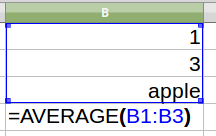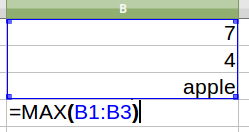Basic Functions
Basic Functions
SUM
Adds all the numbers in a range of cells.
Syntax:
SUM(number1; number2;...number30)
number1 to number30 are up to 30 numbers or ranges of numbers whose sum is to be calculated.
SUM ignores any text or empty cell within a range or array.
Examples:
SUM(2; 3; 4)
returns 9, because 2+3+4 = 9.
SUM(B1:B3)
(where cells B1, B2, B3 contain 5, 4, 3) returns 12.
SUM(B3:B4; D3:E4)
returns 14

AVERAGE
Returns the average of the arguments, ignoring text.
Syntax:
AVERAGE(number1; number2; ... number30)
number1 to number30 are up to 30 numbers or ranges containing numbers.
Examples:
AVERAGE(2; 6; 4)
returns 4, the average of the three numbers in the list.
AVERAGE(B1:B3)
where cells B1, B2, B3 contain 1, 3, and apple returns 2, the average of 1 and 3. Text is ignored.

COUNT
Counts the numbers in the list of arguments, ignoring text entries.
Syntax:
COUNT(value1; value2; ... value30)
value1 to value30 are up to 30 values or ranges representing the values to be counted.
Examples:
COUNT(2; 4; 6; "eight")
returns 3, because 2, 4 and 6 are numbers ("eight" is text).
COUNT(B1:B3)
where cells B1, B2, B3 contain 1, 3, and apple returns 2.

COUNT(B1:B3)
where cells B1, B2, B3 are empty, returns 0.
MAX
Returns the maximum of a list of arguments, ignoring text entries.
Syntax:
MAX(number1; number2; ... number30)
number1 to number30 are up to 30 numbers or ranges containing numbers.
Examples:
MAX(2; 6; 4)
returns 6, the largest value in the list.
MAX(B1:B3)
where cells B1, B2, B3 contain 7, 4, and apple returns 7

MIN
Returns the minimum of a list of arguments, ignoring text entries.
Syntax:
MIN(number1; number2; ... number30)
number1 to number30 are up to 30 numbers or ranges containing numbers.
Example:
MIN(2; 6; 4)
returns 2, the smallest value in the list.
CONCATENATE
Combines several text strings into one string.
Syntax:
CONCATENATE(text1; text2; ... text30)
Text 1; Text 2; ... represent up to 30 text passages which are to be combined into one string.
The ampersand operator & may also be used to concatenate text in a formula, without the function.
Examples:
CONCATENATE("al"; "tog"; "ether")
returns altogether.
"al" & "tog" & "ether"
also returns altogether.
CONCATENATE(A1; A2)
where cell A1 contains "key" and cell A2 contains "board" returns keyboard. ![]()